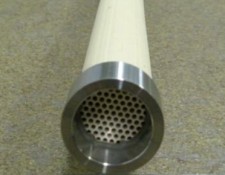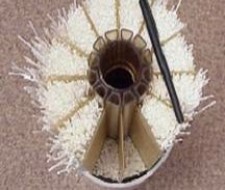
Common anecdotal "wisdom" holds that ceramic micro and ultrafiltration systems, though more robust and forgiving, have such a high capital cost that polymeric membrane systems provide a lower total operating cost advantage. Katie Guerra, P.E., of the Bureau of Reclamation reported on her efforts to put those assumptions to a rigorous literature and actual performance tests to determine the answer.
Pros and cons

Micro- and ultrafiltration processes are slowly but surely replacing the older, much more space intensive clarification and gravity filtration systems for water treatment. In addition to taking much less space, these membrane systems can provide a much smaller size of solid rejection, including many microorganisms. They are also more suitable for automatic and computer control.
Some pros and cons of ceramic and polymeric membrane systems are:
Cermaic membranes: |
Polymeric membranes: |
| Superior mechanical strength | Subject to mechanical damage |
| One "piece" per element | Bundles of hundreds of hollow fibers |
| Good chemical resistance | Polymer can be attacked |
| High capital costs | Lower cost/gpm capacity |
| Little operational experience | Ubiquitous |

There is also anecdotal evidence that ceramic membranes offer a higher flux, foul less and have a longer operating life.
Literature searches
The literature was extensively searched for data relating to all factors of performance on both ceramic and polymeric membranes. All the suitable data was then charted in such a way as to normalize the comparisons. The results of these efforts was...inconclusive. In no performance area where a justifiable comparison could be made was there ever a clear "winner."
The flux is the thing
The next step was to conduct actual trials under conditions as identical as possible in an attempt to quantify differences. The normalizing factor was the Peclet number, taken as flux/mass-transfer coefficient. The filter feed was a 100mg/L bentonite suspension.
Many runs were performed at various flux rates (and hence various Peclet numbers) for both systems, with changes in membrane pressure differentials a measure of instantaneous fouling effects. These test finally started to show some differences, as the polymeric membrane began fouling at Peclet numbers of around 1000, with significantly higher membrane pressures at the ends of those runs. Although the ceramic membrane showed some slight fouling effects at lower Peclet numbers (around 800), the extent of fouling never approached that of the polymeric membranes.
The bottom line

With a performance difference finally evident, the final treatment involved calculating a "total annualized cost" for both systems at various Pectlet numbers across a spectrum of system flows. In the end, the results showed that with the assumptions made and performance results demonstrated, the polymeric membrane systems really are the more cost effective.
Additional investigations on tap include demonstrating the costs and effects of membrane cleanings and an attempt to get better, more market-current membrane pricing, as these costs are one of the more significant drivers of total annualized cost.


